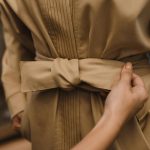You might think ripstop fabric’s lightweight feel means it can’t handle tough tasks, but that’s not the case. Its unique crosshatch weave stops tears from spreading, giving it surprising strength. If you’re considering materials for demanding jobs, understanding how ripstop performs under stress and in harsh conditions could change your perspective. Let’s explore what makes this fabric a reliable choice for heavy-duty use.
Table of Contents
Key Takeaways
- Ripstop fabric’s grid pattern prevents tears from spreading, ensuring superior durability in demanding environments.
- Made from strong fibers like nylon or polyester, ripstop fabric balances lightweight comfort with high strength.
- Coated ripstop fabrics enhance water repellency and abrasion resistance, suitable for harsh weather and rugged use.
- Military and industrial gear use ripstop fabric for reliability and tear resistance under extreme stress.
- Advanced coatings like silicone and polyurethane improve ripstop’s durability, waterproofing, and UV protection for tough jobs.
Understanding Ripstop Fabric Construction and Materials
Ripstop fabric features a unique grid pattern woven into its fibers, which prevents tears from spreading. When you choose ripstop, you’re selecting a material crafted with strong fibers like nylon or polyester, tightly woven for enhanced durability.
This construction makes ripstop ideal for demanding applications such as outdoor gear, military uniforms, and camping equipment. You’ll notice that this fabric balances lightweight comfort with impressive strength.
Understanding ripstop applications helps you appreciate how its design extends fabric longevity, reducing the need for frequent replacements. Whether you’re working in rugged environments or seeking long-lasting textiles, ripstop fabric offers reliable performance.
The Role of Ripstop’s Crosshatch Weave in Tear Resistance
Although tears can start from small punctures or snags, the crosshatch weave in ripstop fabric stops them from spreading further.
When you look closely, you’ll see thicker threads woven at regular intervals, creating a grid pattern. These reinforced threads offer significant crosshatch benefits by distributing stress around the damaged area, preventing a tear from expanding.
This design directly enhances the fabric’s tear resistance, making it ideal for demanding jobs where durability is essential. You won’t have to worry about small rips turning into large holes, as the crosshatch structure contains and limits damage effectively.
Comparing Ripstop Fabric Performance in Harsh Weather Conditions
The crosshatch weave not only prevents tears from spreading but also plays a key role when facing harsh weather conditions.
The crosshatch weave strengthens fabric resilience, crucial for enduring harsh weather conditions.
When you rely on ripstop fabric outdoors, its weather resistance keeps you protected against rain, wind, and snow. Unlike some materials that trap heat, ripstop maintains fabric breathability, allowing moisture and sweat to escape. This balance helps you stay comfortable without sacrificing durability.
However, not all ripstop fabrics perform equally under extreme conditions; coated or laminated versions enhance water repellency, while untreated ones focus more on breathability.
When choosing ripstop for demanding weather, consider the specific finish and fabric weight to match your needs.
Ultimately, ripstop offers a durable, breathable option that stands up well when the weather turns tough.
Applications of Ripstop Fabric in Industrial and Military Settings
You rely on ripstop fabric for military gear that needs to withstand extreme conditions without tearing.
In industrial settings, its durability helps protect workers and equipment from wear and damage.
Let’s explore how this fabric meets the demands of these tough environments.
Military Gear Durability
Countless military professionals rely on ripstop fabric to enhance their gear’s durability in harsh environments. This fabric meets strict military specifications, guaranteeing it withstands extreme wear and tear during missions. When you choose ripstop gear, you boost your tactical performance with materials designed to resist rips, tears, and abrasions. Its lightweight nature doesn’t compromise strength, making it ideal for backpacks, uniforms, and protective covers.
| Feature | Benefit |
|---|---|
| Military Specifications | Guarantees reliability under stress |
| Tear Resistance | Prevents damage during operations |
| Lightweight | Enhances mobility and comfort |
| Abrasion Resistance | Extends gear lifespan |
With ripstop fabric, you get durable military gear that supports demanding tasks without sacrificing comfort or functionality.
Industrial Use Cases
Military-grade ripstop fabric doesn’t just serve soldiers; it’s equally valuable in various industrial settings where durability and resistance matter.
When you work around heavy machinery, you need gear that withstands sharp edges, sparks, and constant abrasion. Ripstop fabric offers just that with its tear-resistant weave, protecting you from unexpected rips and cuts.
You’ll find it in safety equipment like protective jackets, gloves, and tool pouches, all designed to endure harsh conditions without failing. Using ripstop fabric means you get reliable, long-lasting gear that keeps you safe and productive.
Innovations Enhancing Durability and Waterproofing in Ripstop
You’ll find that silicone coatings markedly boost ripstop fabric’s durability and waterproofing.
New weaving techniques also strengthen the fabric’s resistance to tears and wear.
Together, these innovations make ripstop more reliable in tough conditions.
Silicone Coatings Benefits
When you apply silicone coatings to ripstop fabric, you enhance its strength and water resistance considerably.
Silicone coatings create a durable barrier that shields the fabric from abrasion, tearing, and moisture, giving you enhanced protection in demanding conditions. These coatings also improve the fabric’s flexibility, so it won’t crack or degrade easily when bent or stretched.
Plus, silicone’s hydrophobic properties prevent water from penetrating the material, keeping you dry and extending the fabric’s lifespan.
You’ll find that ripstop treated with silicone coatings resists stains and UV damage better, maintaining performance over time.
Advanced Weaving Techniques
Although traditional weaving methods offer solid durability, advanced weaving techniques take ripstop fabric to a new level by enhancing both strength and waterproofing.
You’ll find that innovations like double ripstop and micro-ripstop patterns increase fabric strength without adding bulk. These weaving techniques strategically place thicker reinforcement threads at regular intervals, preventing tears from spreading and boosting overall resilience.
Additionally, some advanced methods incorporate multi-directional weaving, which improves fabric integrity against stress from different angles.
When you choose ripstop fabric made with these innovations, you get superior durability that holds up under demanding conditions.
Enhanced Waterproof Properties
Building on advanced weaving techniques, ripstop fabric also benefits from innovations that boost its waterproof capabilities without sacrificing breathability or weight.
You’ll find that modern waterproof treatments applied to ripstop fabrics create a reliable barrier against moisture, keeping you dry even in heavy rain. These treatments enhance moisture resistance by causing water to bead and roll off the surface rather than soaking in.
While traditional coatings could add bulk or reduce airflow, today’s technologies maintain the fabric’s lightweight feel and ventilation.
When you choose ripstop with enhanced waterproof properties, you’re getting durable protection suited for demanding jobs where exposure to wet conditions is common.
This balance between water defense and breathability means you stay comfortable without compromising on toughness or performance.
Selecting the Right Ripstop Fabric Weight and Coating for Tough Jobs
Choosing the right ripstop fabric weight and coating can make all the difference in how well your gear stands up to tough conditions.
Heavier fabric weight generally offers increased durability and resistance to tears, perfect for demanding jobs. However, it might add bulk, so balance strength with flexibility based on your needs.
Heavier ripstop fabrics boost durability and tear resistance but may add bulk—balance strength with flexibility wisely.
When it comes to coating types, options like polyurethane provide excellent waterproofing and abrasion resistance, while silicone coatings add durability and UV protection without sacrificing breathability.
You’ll want to pick a coating that matches your environment—whether that’s wet, sunny, or abrasive.
Frequently Asked Questions
How Do I Properly Care for and Clean Ripstop Fabric?
You should follow ripstop maintenance tips like hand washing with mild detergent and avoiding bleach. Use gentle cleaning techniques, air dry, and avoid high heat to keep your ripstop fabric in great condition for longer use.
Can Ripstop Fabric Be Repaired if Torn?
You can repair ripstop fabric using various repair techniques like patching methods with iron-on patches or sewing. These approaches restore strength and prevent further tearing, letting you extend your gear’s life effectively and efficiently.
What Are the Environmental Impacts of Producing Ripstop Fabric?
Did you know textile production accounts for 10% of global carbon emissions? You’ll want to explore sustainability practices and eco-friendly alternatives in ripstop fabric production to reduce your environmental footprint effectively.
Is Ripstop Fabric Breathable for Extended Wear?
You’ll find ripstop fabric offers decent breathability features, helping you stay comfortable during extended wear. Its moisture management properties wick sweat away, preventing clinginess and keeping you dry in demanding conditions or warm environments.
How Does Ripstop Fabric Compare in Cost to Other Durable Fabrics?
When you compare ripstop fabric’s cost to other durable fabrics, you’ll find it offers great fabric longevity at a reasonable price. Its durability often justifies the cost, giving you excellent value over time without breaking the bank.
- Does Chiffon Fabric Stink - July 15, 2025
- Does Chiffon Fabric Affect the Economy - July 15, 2025
- Does Cotton Fabric Have a Nap - July 15, 2025







